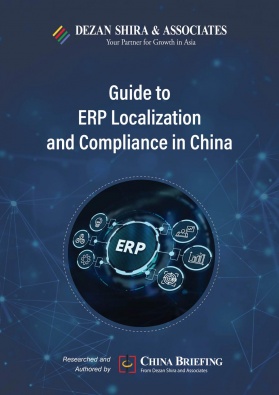China Offers Special Equipment Tax Incentive for Green and Digital Development
A new China tax incentive aims to encourage companies to invest in digital and smart upgrades of special equipment. Companies upgrading certain equipment that aids environmental protection and safe production can enjoy a deduction of the investment at a rate of 10 percent from their corporate income tax payable. We explain the requirements of the new tax incentive.
China’s Ministry of Finance (MOF) and State Tax Administration (STA) have issued a new preferential corporate income tax (CIT) incentive for companies investing in digital and intelligent transformations of certain types of equipment. To be eligible for the incentive, companies must invest in the digital and intelligent transformation of equipment related to energy and water conservation, environmental protection, and safe production.
The new tax incentive aligns with a State Council Action Plan, released in March 2024, which aims to accelerate the renewal of large-scale equipment and consumer goods, promoting high-quality development and driving investment and consumption for long-term benefits.
What is the special equipment tax incentive?
Between January 1, 2024, and December 31, 2027, companies can deduct the investment in the digital and intelligent transformation of special equipment from their CIT payable in the current year at a rate of 10 percent. The investment should not exceed 50 percent of the original tax base when the special equipment was purchased.
If the annual CIT payable is insufficient for the offset, it can be carried forward to future years for up to five years.
The CIT payable refers to the balance after multiplying the annual taxable income by the applicable tax rate and deducting the tax reductions and exemptions according to China’s CIT Law and relevant preferential policies.
Note that companies enjoying the tax incentives must use the transformed equipment themselves. If the equipment is transferred or leased within five tax years after the transformation is completed, the incentives must stop from the month the equipment is no longer in use, and the previously offset CIT must be repaid.
Which equipment is covered by the tax incentive?
The “special equipment” eligible for the preferential tax treatment covers equipment purchased and used by companies listed in the Catalog of Special Equipment for Safe Production for Corporate Income Tax Incentives (2018 Edition) and the Catalog of Special Equipment for Energy Saving, Water Conservation, and Environmental Protection for Corporate Income Tax Incentives (2017 Edition).
These catalogs list a range of special equipment relating to energy and water conservation, environmental protection, and safe production, including exact equipment specifications and implementation. In total, they cover 145 different pieces of equipment. The transformed equipment must meet the conditions specified in these catalogs to be eligible for the tax incentive.
Below is a sample of the types of special equipment included in the catalogs.
| Sample of Special Equipment Eligible for Digital Transformation Tax Incentive | ||
| Category | Equipment type | Equipment |
| Energy and water conservation (32 items) | Electric motors | Small and medium-sized three-phase asynchronous motors |
| Permanent magnet synchronous motors
|
||
| High voltage three-phase cage asynchronous motors | ||
| Water pumps | Clean water centrifugal pumps | |
| Petrochemical centrifugal pumps | ||
| Compressors | Positive displacement air compressors | |
| Environmental protection (24 items) | Water pollution prevention equipment | Membrane bioreactors |
| Sludge dewatering machines | ||
| Air pollution prevention and control equipment | Baghouse filters | |
| Electric bag composite dust collectors | ||
| Safe production (89 items) | Safe production | Gas content and pressure testing equipment |
| Mine underground advanced detection equipment | ||
| Security monitoring equipment | ||
Meanwhile, digital and intelligent transformation of special equipment refers to technical improvements and optimization using information and digital technologies to enhance the digital and intelligence levels of the equipment. This includes the following transformations:
- Data collection: Converting performance parameters, operational status, and environmental information of the equipment into digital form using technologies such as sensing, automatic identification, system reading, and industrial control data parsing.
- Data transmission and storage: Transmitting and storing the collected equipment data using network connections, protocol conversion, and data storage technologies, effectively aggregating the data.
- Data analysis: Conducting in-depth analysis of the collected equipment information using data processing, statistical analysis, modeling, and simulation technologies, improving aspects like fault diagnosis, predictive maintenance, and optimized operation.
- Intelligent control: Upgrading functions like monitoring alerts, dynamic parameter adjustment, and feedback control using automation and intelligent technologies to achieve intelligent control of the equipment.
- Digital security and protection: Enhancing data confidentiality and integrity of the equipment using data encryption, vulnerability scanning, access control, and redundancy backup technologies, significantly improving the capability of data and network security risk prevention.
- Other digital and intelligent transformation scenarios specified by the fiscal and tax authorities in conjunction with the science, industry, and information technology departments.
Special equipment that is leased through financial leasing can be eligible for tax incentives if the ownership is transferred to the lessee at the end of the lease term as agreed in the contract. However, if the ownership is not transferred, the lessee must stop enjoying the incentives and repay the offset CIT.
Which investments are eligible?
The capital investment to upgrade equipment eligible for the tax incentive includes expenditures that form the fixed asset value of the special equipment during the digital and intelligent transformation process. However, this does not include VAT refunds and costs related to transportation, installation, and debugging of the equipment.
Investments in the digital and intelligent transformation of special equipment using government grants cannot be used to offset the annual CIT payable.
Other requirements
Companies must account for the investment in equipment transformation separately and reasonably allocate expenses. If multiple pieces of equipment are transformed in a tax year, expenses must be allocated separately for each piece of equipment. If the expenses are not clearly divided, the company cannot enjoy the tax incentive.
To enjoy the tax incentive, companies must plan the transformation in advance or obtain a registered technical development or service contract from a recognized institution. The relevant documents should be retained for future reference. If the tax authorities cannot accurately determine whether the investment is for the digital and intelligent transformation of special equipment, they can request the industrial and information technology departments at or above the city level in conjunction with science departments to identify it.
About Us
China Briefing is one of five regional Asia Briefing publications, supported by Dezan Shira & Associates. For a complimentary subscription to China Briefing’s content products, please click here.
Dezan Shira & Associates assists foreign investors into China and has done so since 1992 through offices in Beijing, Tianjin, Dalian, Qingdao, Shanghai, Hangzhou, Ningbo, Suzhou, Guangzhou, Dongguan, Haikou, Zhongshan, Shenzhen, and Hong Kong. We also have offices in Vietnam, Indonesia, Singapore, United States, Germany, Italy, India, and Dubai (UAE) and partner firms assisting foreign investors in The Philippines, Malaysia, Thailand, Bangladesh, and Australia. For assistance in China, please contact the firm at china@dezshira.com or visit our website at www.dezshira.com.
- Previous Article China’s New Ethical Guidelines for Human Genome Editing Research
- Next Article China’s Futuristic Industries: Investment Prospects in the Emerging Low-Altitude Economy








